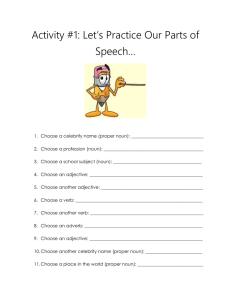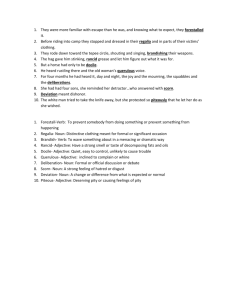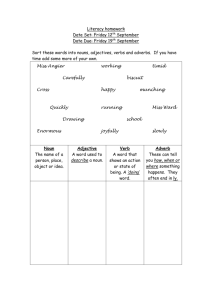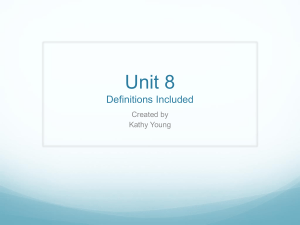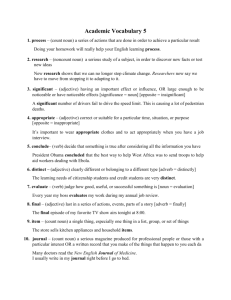spec
advertisement
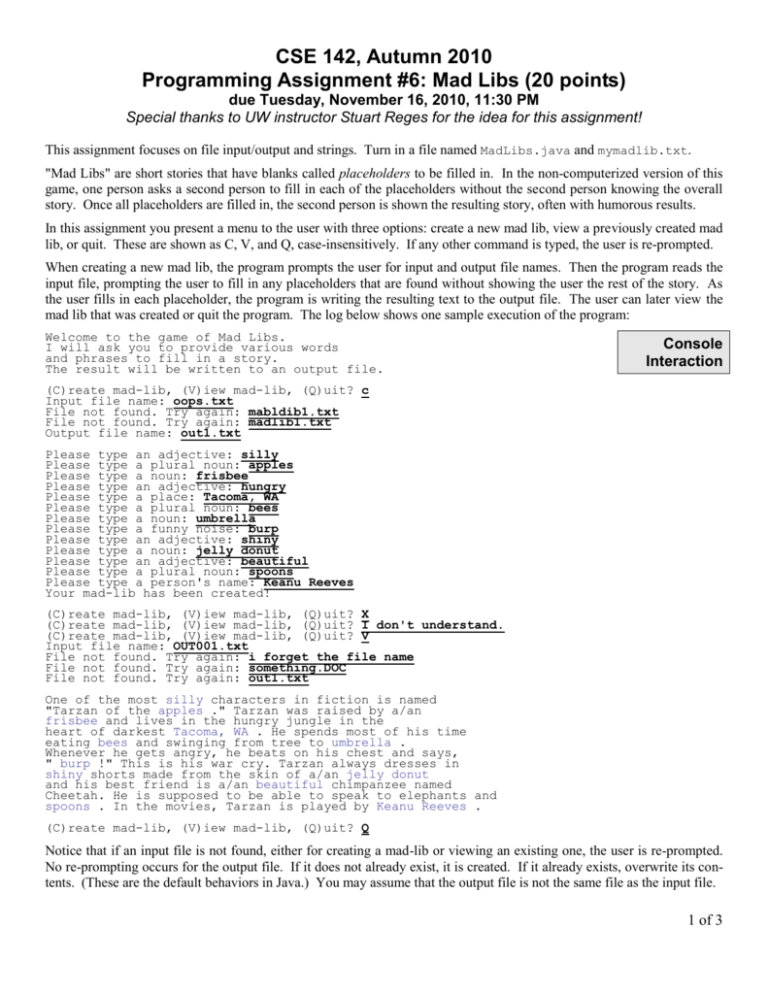
CSE 142, Autumn 2010 Programming Assignment #6: Mad Libs (20 points) due Tuesday, November 16, 2010, 11:30 PM Special thanks to UW instructor Stuart Reges for the idea for this assignment! This assignment focuses on file input/output and strings. Turn in a file named MadLibs.java and mymadlib.txt. "Mad Libs" are short stories that have blanks called placeholders to be filled in. In the non-computerized version of this game, one person asks a second person to fill in each of the placeholders without the second person knowing the overall story. Once all placeholders are filled in, the second person is shown the resulting story, often with humorous results. In this assignment you present a menu to the user with three options: create a new mad lib, view a previously created mad lib, or quit. These are shown as C, V, and Q, case-insensitively. If any other command is typed, the user is re-prompted. When creating a new mad lib, the program prompts the user for input and output file names. Then the program reads the input file, prompting the user to fill in any placeholders that are found without showing the user the rest of the story. As the user fills in each placeholder, the program is writing the resulting text to the output file. The user can later view the mad lib that was created or quit the program. The log below shows one sample execution of the program: Welcome to the game of Mad Libs. I will ask you to provide various words and phrases to fill in a story. The result will be written to an output file. Console Interaction (C)reate mad-lib, (V)iew mad-lib, (Q)uit? c Input file name: oops.txt File not found. Try again: mabldib1.txt File not found. Try again: madlib1.txt Output file name: out1.txt Please type an adjective: silly Please type a plural noun: apples Please type a noun: frisbee Please type an adjective: hungry Please type a place: Tacoma, WA Please type a plural noun: bees Please type a noun: umbrella Please type a funny noise: burp Please type an adjective: shiny Please type a noun: jelly donut Please type an adjective: beautiful Please type a plural noun: spoons Please type a person's name: Keanu Reeves Your mad-lib has been created! (C)reate mad-lib, (V)iew mad-lib, (Q)uit? X (C)reate mad-lib, (V)iew mad-lib, (Q)uit? I don't understand. (C)reate mad-lib, (V)iew mad-lib, (Q)uit? V Input file name: OUT001.txt File not found. Try again: i forget the file name File not found. Try again: something.DOC File not found. Try again: out1.txt One of the most silly characters in fiction is named "Tarzan of the apples ." Tarzan was raised by a/an frisbee and lives in the hungry jungle in the heart of darkest Tacoma, WA . He spends most of his time eating bees and swinging from tree to umbrella . Whenever he gets angry, he beats on his chest and says, " burp !" This is his war cry. Tarzan always dresses in shiny shorts made from the skin of a/an jelly donut and his best friend is a/an beautiful chimpanzee named Cheetah. He is supposed to be able to speak to elephants and spoons . In the movies, Tarzan is played by Keanu Reeves . (C)reate mad-lib, (V)iew mad-lib, (Q)uit? Q Notice that if an input file is not found, either for creating a mad-lib or viewing an existing one, the user is re-prompted. No re-prompting occurs for the output file. If it does not already exist, it is created. If it already exists, overwrite its contents. (These are the default behaviors in Java.) You may assume that the output file is not the same file as the input file. 1 of 3 Input Data Files: You will need to download the example input files from our web site and save them to the same folder as your program. Mad lib input files are mostly just plain text, but they may also contain placeholders. Placeholders are represented as input tokens that begin and end with < and > . For example, the file madlib1.txt used in the previous log contains: One of the most <adjective> characters in fiction is named "Tarzan of the <plural-noun> ." Tarzan was raised by a/an <noun> and lives in the <adjective> jungle in the heart of darkest <place> . He spends most of his time eating <plural-noun> and swinging from tree to <noun> . Whenever he gets angry, he beats on his chest and says, " <funny-noise> !" This is his war cry. Tarzan always dresses in <adjective> shorts made from the skin of a/an <noun> and his best friend is a/an <adjective> chimpanzee named Cheetah. He is supposed to be able to speak to elephants and <plural-noun> . In the movies, Tarzan is played by <person's-name> . Input File madlib1.txt Your program should break the input into lines and into tokens using a Scanner so that you can look for all its placeholders. Normal non-placeholder word tokens can be written directly to the output file as-is, but placeholder tokens cause the user to be prompted. The user's response to the prompt is written to the output file, rather than the placeholder itself. You should accept whatever response the user gives, even a multi-word answer or a blank answer. You may assume that each word/token from the input file is separated by neighboring words by a single space. In other words, when you are writing the output, you may place a single space after each token to separate them. You do not need to worry about blank spaces at the end of lines of the output file. It's okay to place a space after each line's last token. Sometimes a placeholder has multiple words in it, separated by a hyphen ( - ), such as <proper-noun>. As your program discovers a placeholder, it should convert any such hyphens into spaces. Any hyphens that appear outside of a placeholder, such as in the other text of the story, should be retained and not converted into spaces. When prompting the user to fill in a placeholder, give a different prompt depending on whether the placeholder begins with a vowel (a, e, i, o, or u, case-insensitively). If so, prompt for a response using "an". If not, use "a". For example: Placeholder <noun> <adjective> <plural-noun> <Emotional-Actor's-NAME> Resulting Prompt Please Please Please Please type type type type a noun: an adjective: a plural noun: an Emotional Actor's NAME: Do not make unnecessary assumptions about the input. For example, an input file could have < and > characters in it that are not part of placeholders, and these should be retained and included in the output. You may assume that a placeholder token will contain at least one character between its < and > (in other words, no file will contain the token <> ). You may assume that a placeholder will appear entirely on a single line; no placeholder will ever span across multiple lines. Your output mad lib story must retain the original placement of the line breaks from the input story. When you are viewing an existing mad lib story, you are simply reading and echoing its contents to the console. You do not need to do any kind of testing to make sure that the story came from a mad lib input file; just output the file's contents. Your program's menu should work properly regardless of the order or number of times its commands are chosen. For example, the user should be able to run each command (such as C or V) many times if so desired. The user should also be able to run the program again later and choose the V option without first choosing the C option on that run. The user should be able to run the program and immediately quit with the Q option if so desired. And so on. Creative Aspect (mymadlib.txt): Along with your program, submit a file mymadlib.txt with a story of your own creation, in a format suitable for use as input to your program. Look at the sample input on the web site as examples. For full credit, your story should be at least 8 lines long and at least five (5) placeholders. 2 of 3 Implementation and Development Strategy: Read/write files using Scanners and PrintStreams, passing File parameters. Remember to import java.io.*; Read all console user input using the Scanner's nextLine method (not next, which permits only one-word answers). When reading files, you may need a mixture of line-based and token-based processing as shown in Chapter 6. To re-prompt for input file names, you need to know whether a file with a given name exists. You can do this by using methods from File objects as shown in class. The textbook shows an alternative technique for solving the file-not-found problem called a try/catch statement, but we do not recommend using this on your assignment. You will need to use several String methods to search for and replace characters. See textbook sections 3.3 and 4.3-4.4. In particular you may use the replace method to replace occurrences of one character with another. For example: String str = "mississippi"; str = str.replace("s", "*"); // str = "mi**i**ippi" Incorrect file input often leads to exceptions. If you get an InputMismatchException, you are trying to read the wrong type of value from a Scanner. If you get a NoSuchElementException, you are trying to read past the end of a file or line. If you get an exception, look at the exception's text to find the relevant line number in your file. For example: Exception in thread "main" java.util.NoSuchElementException: No line found at java.util.Scanner.nextLine(Scanner.java:1516) at MadLibs.myMethodName(MadLibs.java:73) at MadLibs.main(MadLibs.java:20) After finding the line number, use println statements or the debugger to see the values of each variable as it is read. A common bug is calling next, nextLine, etc. on the wrong Scanner, so examine those calls carefully. As you are developing the program, you may want to initially "hard-code" the input and output filenames; in other words, you may want to just use fixed file names in your code rather than prompting the user to enter the file names. You may also want to temporarily print extra "debug" text to the console while developing your program, such as printing each token or placeholder's text as you read it from the input file. It is easier to debug this program when using a smaller input file with fewer placeholders. On the course web site we have posted an input file madlib0.txt with a much shorter mad lib story. You may want to use this as a testing file at first. Style Guidelines: Structure your solution using static methods that accept parameters and return values as appropriate. It is okay to have methods that return objects, such as a File or Scanner or PrintStream. Objects can also be passed as parameters. For full credit, you must have at least 4 non-trivial methods other than main in your program. It is okay for some println statements and code to be in main, as long as you use good structure and main is a concise summary. It is also okay for the main UI menu loop to be in main, as long as the code inside that loop is short and elegant. Each method should have a single coherent purpose, and no one method should do too large a share of the overall task. The main method should not directly perform a large share of the work itself, such as actually reading the mad lib input file and producing the output. Avoid "chaining" many calls together without ever returning to main. As a reference, our solution has 5 methods besides main and occupies roughly 110 lines (65 substantive lines) including comments. We will be especially picky about redundancy and structure on this assignment. If you have repeated code, put it into a method or loop so that it needs to be written only once. If a method is too long or incoherent, split it into smaller pieces. For this assignment you are limited to the language features in Chapters 1 through 6 of the textbook. In particular, you are not allowed to use arrays on this assignment. Use whitespace and indentation properly. Limit lines to 100 characters. Give meaningful names to methods/variables, and follow Java's naming standards. Localize variables. Put descriptive comments at the start of your program, at the start of each method, and inside methods on complex sections of code. 3 of 3
